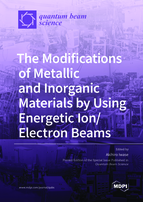Effects of Beam Conditions in Ground Irradiation Tests on Degradation of Photovoltaic Characteristics of Space Solar Cells
Round 1
Reviewer 1 Report
I think the paper is very relevant for the field. The paper is very well written and clear and the methodology robust. My only comment is that in figure 7.a) the higher degradation in the Si solar cells with the higher fluence rate is exclusively attributable to temperature rise with higher fluence rate. Is there a correction factor that can be applied? can we try to decouple both effects? In order words is only temperature what we are seeing?
Author Response
Thank you for your review. We appreciate your comment.
We attributed the difference in degradation of the silicon cell to the temperature during irradiation, and the detail have been described in Ref. 7. However, it is very difficult to discuss about the temperature effect precisely only from the obtained results in this study. Even if we derive a correction factor (it may be possible), it will be applicable only for the particular sample silicon solar cell, which is not so significant. Therefore, we are currently investigating the effects of temperature during irradiation tests using other types of solar cells. We will publish the results elsewhere later.
Reviewer 2 Report
The paper deals with investigations of the effects of irradiation beam conditions on output performance degradation of a silicon and a triple-junction space solar cell. Probably, such investigations can be important for the development of standards for irradiation test methods for space solar cell, however, it is difficult to find any new scientific results in this paper. It contains only a description of results obtained without any their discussion. In experiments with the fluence rate it is important to understand the purpose of such experiments and the possible reasons for the differences because it can help in the choice of appropriate experimental conditions. However, this point is also not discussed. The same can be said about the study of the dependence on expansion methods. Moreover, it is difficult to understand the parameters of scanning because only the Horizontal and Vertical scan frequencies are shown. It is not enough, because if the authors expect some mechanism of scanning effect the choice of the scanning rate will depend on this mechanism. If line scanning is used it is important to know a number of lines and a distance between them and so on.
Author Response
Thank you for your review. We appreciate your comments.
About the purpose of this study, examining the effects of fluence rate and beam-area expansion methods on degradation, it is described in the top paragraph in the Experimental section. We added a sentence which indicates that they are the purpose. Please find it.
The primary purpose of this paper is not a physical analysis of degradation but dependence of degradation on irradiation test conditions. In addition, since no dependency on the selected conditions was found, it is difficult to discuss "physical reasons" of the obtained results which showed "no change." It is almost impossible to explain a phenomenon from no-dependency data. If we do it, it may result in some speculation which is not so significant. These are the reasons we have avoided "physical" discussion about the results. What we can say most from the results are described in the last paragraphs of the two subsections in the Results and Discussion section. Please understand.
What we tried to find out in this study was not the effect of scanning method itself but the difference in degradation between the scanning and defocusing methods. However, we noticed that a few important information was missing in the description of the scanning experiment, which were the beam spot size and the beam area. We added the information in Table 3 and 4. Using the frequencies shown in the tables and the beam spots with the sizes, all the irradiation area is covered by the protons (no void area). We confirmed it right before the each irradiation test by using an alumina fluorescent plate. We added such description in the text.
Reviewer 3 Report
In my opinion, the paper is nice and well written and can be accepted as it is.
Author Response
Thank you for your review. We very much appreciate your comment.
We have added some descriptions according to other reviewer's comments and improved English quality in the resubmitted manuscript. Please find it.





